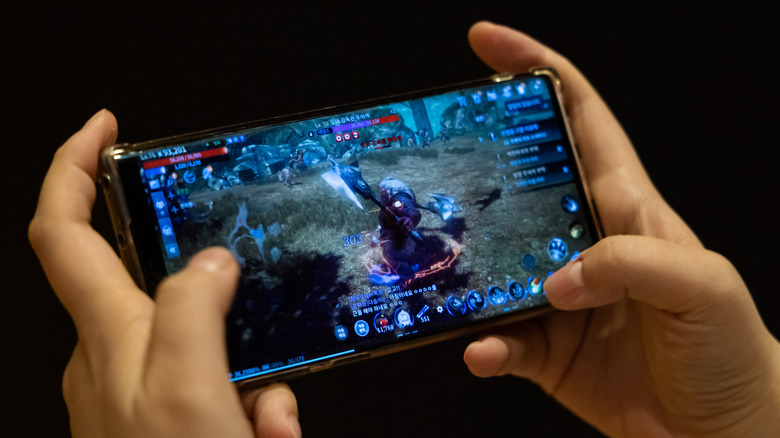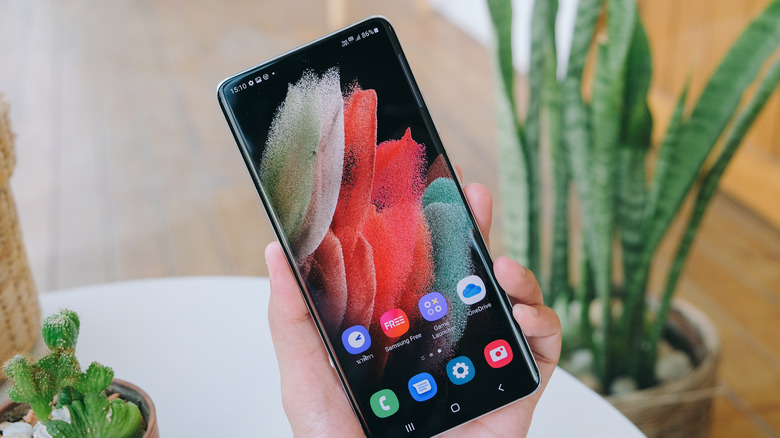What Is VRR? Breaking Down Variable Refresh Rate
Display refresh rates are a hot topic at the moment across consumer electronics devices that feature –- you guessed it –- a display. Over the past year, the subject has come up again with the latest smartphones. According to Intel, a display's refresh rate refers to how many times per second the display is able to draw a new image. This occurs regardless of whether the images shown on the screen change or not, as modern displays are designed to quickly adjust to changes in either input from a user or in response to new images being shown. Variable refresh rate is the ability of your screen to vary how often it refreshes in order to match the frame rate.
Most modern displays — whether on a TV, monitor, or smartphone — have a minimum refresh rate of 60 Hz (via Tech Radar). For many people, displays with a 60 Hz refresh rate are good enough. For example, CNET noted that most content shown on a TV will manage with a 60 Hz refresh range. Movies, TV shows, and sports channels typically show content between 24 fps, 30 fps, or up to 60 fps. The frames per second refers to how many shots per second were used when recording the content on a video or film camera. With screen refresh rates refreshing every second, content will generally look better when the content's frames per second align with the display's refresh rate as a minimum requirement.
What is Variable refresh rate?
Variable refresh rate refers to the ability of your screen to adjust how often it refreshes what is being displayed. It does this in order to match the frame rate of the device you are using — that could be a computer, smartphone, or another electronic device.
As noted above, programs including movies, games, and television shows have a set frame rate. But that frame rate isn't always directly on par with what your screen is capable of displaying. So, VRR is the term used to describe the technology that allows your screen's refresh rate to match up to the media you are playing.
One thing you'll notice is that the refresh rate of your personal devices is generally not equal to other devices you own. Your phone, TV, and computer screen likely have different refresh rates. As Benq notes, monitors have a higher refresh rate than television screens, for example, which makes them better for gaming than other screens.
Benefits of VRR and when it's not necessary
Variable refresh rate makes the user experience better because it directly matches the refresh rate of the display screen with the frame rate of the signal, as noted above. This minimizes screen tearing and shuttering (via Gadget Review). Gamers, of course, love this. And, on smartphones, VRR minimizes the "blur" caused by rapid scrolling — something that used to plague phone users who frequently read articles, emails, and other long-form texts on their devices.
Movie and television fans also love VRR because it helps to optimize the viewing experience and keep it consistent across different players.
On the other hand, if you use a device primarily for very basic tasks like texting and calls, VRR doesn't need to be a priority for you. It's not going to have a negative impact on your experience, but it won't be worth paying extra for, either.
Variable refresh rates and gaming
Variable refresh rates have also become a big deal when it comes to PC and console gaming. The reason for this is that when a computer or console outputs content that doesn't match the frequency of a monitor's refresh rate, an unwanted effect known as screen tearing occurs (via Display Ninja). This looks like a ripple or a split that runs across the screen and it can be very annoying and disruptive, especially if you have the enemy in your sights and are about to nerf them. This is where adaptive sync technology, like NVIDIA's G-Sync or AMD's FreeSync can come in very handy, as CNET notes that they vary the refresh rate of the display to exactly match the frames per second of your system's graphics card.
VRR technology like G-Sync and FreeSync, however, require each component in the chain to support the technology (via CNET). This means that your graphics card must support the technology along with your monitor. If you are using an Xbox Series X console, you will need to enable this feature in the settings. IGN found that newer gaming monitors support high refresh rates (HRR) that start at around 100 to 120 Hz and go all the way up to 360 Hz. Having a compatible monitor that can vary its refresh rate according to frames per second output through a compatible GPU will make a big difference to how smooth and stutter-free your visuals will look.
Variable refresh rates and smartphones
Smartphones have become the latest battleground when it comes to display refresh rates. Razer was the first to introduce a high refresh rate smartphone in the form of its Razer Phone which had a 120 Hz display back in 2017. As a gaming-oriented brand, it was pushing the display technology as a way to get a better visual experience when gaming along with a lag and stutter-free experience, in particular with the Razer Phone 2 (via Wired).
Smartphone users also do a lot of scrolling, and having a high refresh rate helps to make that experience much smoother as it reduces the blur associated with scrolling through text. However, the problem with high refresh rates, particularly with those that are static, is that they can chew through a lot of battery life. This is where VRR can also come in handy. The Samsung Galaxy S21 Ultra was one of the first phones on the market with a VRR display, also referred to as a dynamic refresh rate. The aim of the technology is to save battery life by adapting the refresh rate to the content being displayed (via Microsoft DirectX Developer Blog). The benefit of more finely tuning refresh rates and content frames per second on a smartphone (such as with the iPhone 13 Pro) is better visuals coupled with decent battery life.




